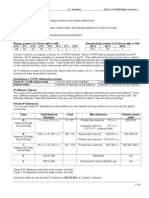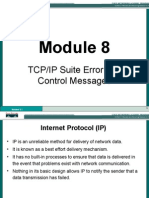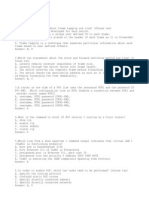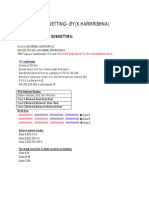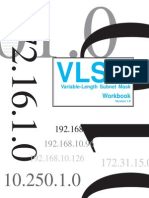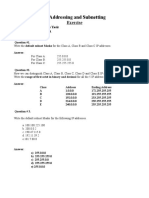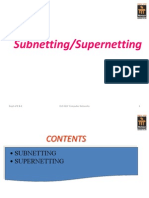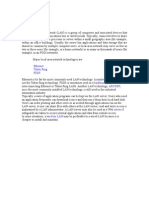Data Communication and Networking: Subnetting by MR - Chishala G
Data Communication and Networking: Subnetting by MR - Chishala G
Uploaded by
Michael Siame0 ratings0% found this document useful (0 votes)
43 views24 pagesSubnetting allows large networks to be divided into smaller, more manageable subnets. It involves taking bits from the host portion of the IP address and using them to define the subnet. The key steps are determining the number of subnets and hosts needed, then selecting a subnet mask that meets the requirements. Common techniques for subnetting include classful routing with a standard mask, and classless inter-domain routing (CIDR) which uses a slash notation to specify the mask. Key aspects of subnetting include calculating the number of subnets and hosts, identifying valid subnet and host addresses, and determining the broadcast address for each subnet.
Original Description:
Original Title
ICT320 LECTURE 5
Copyright
© © All Rights Reserved
Available Formats
PPTX, PDF, TXT or read online from Scribd
Share this document
Did you find this document useful?
Is this content inappropriate?
Report this DocumentSubnetting allows large networks to be divided into smaller, more manageable subnets. It involves taking bits from the host portion of the IP address and using them to define the subnet. The key steps are determining the number of subnets and hosts needed, then selecting a subnet mask that meets the requirements. Common techniques for subnetting include classful routing with a standard mask, and classless inter-domain routing (CIDR) which uses a slash notation to specify the mask. Key aspects of subnetting include calculating the number of subnets and hosts, identifying valid subnet and host addresses, and determining the broadcast address for each subnet.
Copyright:
© All Rights Reserved
Available Formats
Download as PPTX, PDF, TXT or read online from Scribd
Download as pptx, pdf, or txt
0 ratings0% found this document useful (0 votes)
43 views24 pagesData Communication and Networking: Subnetting by MR - Chishala G
Data Communication and Networking: Subnetting by MR - Chishala G
Uploaded by
Michael SiameSubnetting allows large networks to be divided into smaller, more manageable subnets. It involves taking bits from the host portion of the IP address and using them to define the subnet. The key steps are determining the number of subnets and hosts needed, then selecting a subnet mask that meets the requirements. Common techniques for subnetting include classful routing with a standard mask, and classless inter-domain routing (CIDR) which uses a slash notation to specify the mask. Key aspects of subnetting include calculating the number of subnets and hosts, identifying valid subnet and host addresses, and determining the broadcast address for each subnet.
Copyright:
© All Rights Reserved
Available Formats
Download as PPTX, PDF, TXT or read online from Scribd
Download as pptx, pdf, or txt
You are on page 1of 24
DATA SUBNETTING
COMMUNICATION AND By Mr.Chishala G.
Email:gmakunka@gmail.com
NETWORKING
SUBNETTING
By now you know that having one large network is not a good thing.
But how would you fix the out of control problem that Figure 5.1 illustrates?
Wouldn’t it be nice to be able to break up that one, huge network address and
create four manageable networks from it.
To make that happen, you would need to apply the infamous trick of subnetting
because it’s the best way to break up a giant network into a bunch of smaller
ones.
Fig 5.1 One network
SUBNETTING
Take a look at Figure 5.2 and see how this might look.
Fig 5.2 Multiple networks connected together
SUBNETTING
How to Create Subnets
Creating subnetworks is essentially the act of taking bits from the host portion of the address
and reserving them to define the subnet address instead.
Clearly this will result in fewer bits being available for defining your hosts.
In this first section, we’ll be discussing classful routing, which refers to the fact that all hosts (nodes) in the network are using the
exact same subnet mask.
to create a subnet, we’ll start by fulfilling these three steps:
1.Determine the number of required network IDs:
One for each LAN subnet
One for each wide area network connection
2. Determine the number of required host IDs per subnet:
One for each TCP/IP host
One for each router interface
3. Based on the above requirements, create the following:
A unique subnet mask for your entire network
A unique subnet ID for each physical segment
A range of host IDs for each subnet
SUBNETTING
Subnet Masks:
For the subnet address scheme to work, every machine on the network must know which
part of the host address will be used as the subnet address.
This condition is met by assigning a subnet mask to each machine.
A subnet mask is a 32-bit value that allows the device that’s receiving IP packets to distinguish
the network ID portion of the IP address from the host ID portion of the IP address.
This 32-bit subnet mask is composed of 1s and 0s, where the 1s represent the positions that refer
to the network subnet addresses.
Not all networks need subnets, and if not, it really means that they’re using the default
subnet mask, which is basically the same as saying that a network doesn’t have a subnet
address.
Table 5.1 shows the default subnet masks for Classes A, B, and C.
SUBNETTING
Default subnet mask:
SUBNETTING
Understanding powers of 2:
SUBNETTING
Classless Inter-Domain Routing (CIDR):It’s basically the method that Internet service
providers (ISPs) use to allocate a number of addresses to a company, a home.
They provide addresses in a certain block size, When you receive a block of addresses from an
ISP, what you get will look something like this: 192.168.10.32/28.
This is telling you what your subnet mask is. The slash notation (/) means how many bits are
turned on (1s). Obviously, the maximum could only be /32 because a byte is 8 bits and there are 4
bytes in an IP address: (4 x 8 = 32)
But keep in mind that regardless of the class of address, the largest subnet mask available can
only be a /30 because you’ve got to keep at least 2 bits for host bits.
Take, for example, a Class A default subnet mask, which is 255.0.0.0. This tells us that the first
byte of the subnet mask is all ones (1s), or 11111111.
When referring to a slash notation, you need to count all the 1-bits to figure out your mask. The
255.0.0.0 is considered a /8 because it has 8 bits that are 1s—that is, 8 bits that are turned on.
A Class B default mask would be 255.255.0.0, which is a /16 because 16 bits are ones (1s):
11111111.11111111.00000000.00000000.
SUBNETTING
Table 5.2 has a listing of every available subnet mask and its equivalent CIDR slash notation.
SUBNETTING
SUBNETTING
SUBNETTING
The /8 through /15 can only be used with Class A network addresses. /16 through /23 can be used
by Class A and B network addresses.
The /24 through /30 can be used by Class A, B, and C network addresses.
This is a big reason why most companies use Class A network addresses.
Since they can use all subnet masks, they get the maximum flexibility in network design. you
cannot configure a router using this slash format.
Nevertheless, it’s really important for you to know subnet masks in the slash notation (CIDR)
Subnetting Class C Addresses:
There are many different ways to subnet a network. The right way is the way that works best for
you.
In a Class C address, only 8 bits are available for defining the hosts. Remember that subnet bits
start at the left and move to the right, without skipping bits.
This means that the only Class C subnet masks can be the following:
SUBNETTING
Binary Decimal CIDR
---------------------------------------------------------
00000000 = 255.255.255.0 /24
10000000 = 255.255.255.128 /25
11000000 = 255.255.255.192 /26
11100000 = 255.255.255.224 /27
11110000 = 255.255.255.240 /28
11111000 = 255.255.255.248 /29
11111100 = 255.255.255.252 /30
We can’t use a /31 or /32 because, we must have at least 2 host bits for assigning IP addresses to
hosts.
we can never use a /32 because that would mean zero host bits available
SUBNETTING
When you’ve chosen a possible subnet mask for your network and need to determine the number of
subnets, valid hosts, and the broadcast addresses of a subnet that mask will provide,
all you need to do is answer five simple questions:
1.How many subnets does the chosen subnet mask produce?
2.How many valid hosts per subnet are available?
3.What are the valid subnets?
4. What’s the broadcast address of each subnet?
5.What are the valid hosts in each subnet?
This is where you’ll be really glad you followed my advice and took the time to memorize your
powers of 2. If you didn’t, now would be a good time…
Here’s how you arrive at the answers to those five big questions:
SUBNETTING
How many subnets? 2^x = number of subnets. x is the number of masked bits, or the 1s. For example,
in 11000000, the number of 1s gives us 2^2 subnets. So in this example, there are 4 subnets.
How many hosts per subnet? 2^y – 2 = number of hosts per subnet. y is the number of unmasked bits,
or the 0s.
For example, in 11000000, the number of 0s gives us 26 – 2 hosts, or 62 hosts per subnet.
You need to subtract 2 for the subnet address and the broadcast address, which are not valid hosts.
What are the valid subnets? 256 – subnet mask = block size, or increment number.
An example would be the 255.255.255.192 mask, where the interesting octet is the fourth octet.
Just use this math: 256 – 192 = 64. The block size of a 192 mask is always 64.
Start counting at zero in blocks of 64 until you reach the subnet mask value and these are your
subnets in the fourth octet: 0, 64, 128, 192. Easy, not so?
SUBNETTING
What’s the broadcast address for each subnet? Now here’s the really easy part.
Since we counted our subnets in the last section as 0, 64, 128, and 192, the
broadcast address is always the number right before the next subnet.
For example, the 0 subnet has a broadcast address of 63 because the next subnet is
64.
The 64 subnet has a broadcast address of 127 because the next subnet is 128, and
so on.
Remember, the broadcast address of the last subnet is always 255.
What are the valid hosts? Valid hosts are the numbers between the subnets.
For example, if 64 is the subnet number and 127 is the broadcast address, then 65–
126 is the valid host range.
Your valid range is always the group of numbers between the subnet address and
the broadcast address
SUBNETTING
Practice Example #1C: 255.255.255.128 (/25)
Since 128 is 10000000 in binary, there is only 1 bit for subnetting and 7 bits for hosts.
We’re going to subnet the Class C network address 192.168.10.0.
192.168.10.0 = Network address
255.255.255.128 = Subnet mask
Now, let’s answer our big five:
How many subnets? Since 128 is 1 bit on (10000000), the answer would be 2^1 = 2.
How many hosts per subnet? We have 7 host bits off (10000000), so the equation would be
2^7 – 2 = 126 hosts.
Once you figure out the block size of a mask, the amount of hosts is always the block size
minus 2. No need to do extra math if you don’t need
SUBNETTING
What are the valid subnets? 256 – 128 = 128. Remember, we’ll start at zero and count in our block
size, so our subnets are 0, 128.
By just counting your subnets when counting in your block size, you really don’t need to do steps
1 and 2.
We can see we have two subnets, and in the step before this one, just remember that the amount of
hosts is always the block size minus 2, and in this example, that gives us 2 subnets, each with 126
hosts.
What’s the broadcast address for each subnet? The number right before the value of the next
subnet is all host bits turned on and equals the broadcast address.
For the zero subnet, the next subnet is 128, so the broadcast of the 0 subnet is 127.
What are the valid hosts? These are the numbers between the subnet and broadcast address.
The easiest way to find the hosts is to write out the subnet address and the broadcast address,
which makes valid hosts completely obvious.
SUBNETTING
The following table shows the 0 and 128 subnets, the valid host ranges of each, and the broadcast
address of both subnets:
SUBNETTING
Implementing a Class C /25 logical network would be as follows:
SUBNETTING
Practice Example #2C: 255.255.255.192 (/26):
This time, we’re going to subnet the network address 192.168.10.0 using the subnet mask
255.255.255.192.
192.168.10.0 = Network address
255.255.255.192 = Subnet mask
Now, let’s answer the big five:
How many subnets? Since 192 is 2 bits on (11000000), the answer would be 2^2 = 4 subnets.
How many hosts per subnet? We have 6 host bits off (11000000), giving us 26 – 2 = 62 hosts.
The amount of hosts is always the block-size minus 2.
What are the valid subnets? 256 – 192 = 64. Remember, to start at zero and count in our block size.
This means our subnets are 0, 64, 128, and 192. We can see we have a block size of 64, so we have 4
subnets, each with 62 hosts.
SUBNETTING
What’s the broadcast address for each subnet? The number right before the value of the next
subnet is all host bits turned on and equals the broadcast address.
For the zero subnet, the next subnet is 64, so the broadcast address for the zero subnet is 63.
What are the valid hosts? These are the numbers between the subnet and broadcast address.
As I said, the easiest way to find the hosts is to write out the subnet address and the broadcast
address, which clearly delimits our valid hosts.
The following table shows the 0, 64, 128, and 192 subnets, the valid host ranges of each, and the
broadcast address of each subnet:
SUBNETTING
you can see that we can now subnet a /26 as long as we can count in increments of 64.
what are you going to do with this fascinating information? Implement it! We’ll use Figure below
shows a /26 network implementation.
SUBNETTING
The /26 mask provides four subnetworks, and we need a subnet for each router interface.
With this mask, in this example, we actually have room with a spare subnet to add to another router
interface in the future. Always plan for growth if possible.
---------------------------------------------------------------------------------------------------------------------------
Quiz 5.
Given a network address 192.168.10.0/27, get the maximum subnets and show its implementation.
----------------------------------------------------------------------------------------------------------------------------
You might also like
- IPv4 Addressing and Subnetting Workbook - Student Version v2.1Document89 pagesIPv4 Addressing and Subnetting Workbook - Student Version v2.1Jordan Krout50% (2)
- Sub Netting PracticeDocument12 pagesSub Netting PracticeSuzette Sabido100% (7)
- Subnetting Examples - Jeremy CioaraDocument7 pagesSubnetting Examples - Jeremy Cioarapiljug50% (2)
- Subnetting A Network Using The CIDR Method Worksheet 1Document3 pagesSubnetting A Network Using The CIDR Method Worksheet 1Abu NadrahNo ratings yet
- Cisco CCNA Command Guide: An Introductory Guide for CCNA & Computer Networking Beginners: Computer Networking, #3From EverandCisco CCNA Command Guide: An Introductory Guide for CCNA & Computer Networking Beginners: Computer Networking, #3No ratings yet
- IPv4 Subnetting for Beginners: Your Complete Guide to Master IP Subnetting in 4 Simple Steps: Computer Networking, #1From EverandIPv4 Subnetting for Beginners: Your Complete Guide to Master IP Subnetting in 4 Simple Steps: Computer Networking, #1Rating: 5 out of 5 stars5/5 (3)
- Lab - Calculate Ipv4 Subnets: ObjectivesDocument4 pagesLab - Calculate Ipv4 Subnets: ObjectivesJad Abou ZeidNo ratings yet
- 11 Subnetting QuestionsDocument2 pages11 Subnetting QuestionsRaine CarrawayNo ratings yet
- Chapter Bit ManipulationDocument14 pagesChapter Bit ManipulationSWAPNILNo ratings yet
- Subnetting ProblemsDocument17 pagesSubnetting ProblemsVishwa SinghNo ratings yet
- 2 0 SubnettingDocument16 pages2 0 SubnettingItalo Saldaña Sandoval100% (1)
- Lesson 2: Subnetting BasicsDocument30 pagesLesson 2: Subnetting BasicsMahmmoud MahdiNo ratings yet
- IP Subnet CalculationsDocument27 pagesIP Subnet Calculationsrajasekr1No ratings yet
- Net LA-03EN SubnettingDocument20 pagesNet LA-03EN SubnettinggNo ratings yet
- WAN TECHNOLOGY FRAME-RELAY: An Expert's Handbook of Navigating Frame Relay NetworksFrom EverandWAN TECHNOLOGY FRAME-RELAY: An Expert's Handbook of Navigating Frame Relay NetworksNo ratings yet
- Network with Practical Labs Configuration: Step by Step configuration of Router and Switch configurationFrom EverandNetwork with Practical Labs Configuration: Step by Step configuration of Router and Switch configurationNo ratings yet
- IPv6 Fundamentals: Learn the Basics of How IPv6 Works, IPv6 Addresses and IPv6 Subnetting: Computer Networking, #2From EverandIPv6 Fundamentals: Learn the Basics of How IPv6 Works, IPv6 Addresses and IPv6 Subnetting: Computer Networking, #2Rating: 4.5 out of 5 stars4.5/5 (2)
- Ipv4 Subnetting: Khawar Butt Ccie # 12353 (R/S, Security, SP, DC, Voice, Storage & Ccde)Document16 pagesIpv4 Subnetting: Khawar Butt Ccie # 12353 (R/S, Security, SP, DC, Voice, Storage & Ccde)madanmohan22100% (1)
- IPv4 Address Subnetting Part 2Document2 pagesIPv4 Address Subnetting Part 2mueller_gbNo ratings yet
- IP Addressing and Subnetting: ExercisesDocument10 pagesIP Addressing and Subnetting: ExercisesKastuv Mani TuladharNo ratings yet
- Subnet Mask Cheat Sheet: Guide To Sub-Class C BlocksDocument3 pagesSubnet Mask Cheat Sheet: Guide To Sub-Class C BlocksTotNo ratings yet
- Subnetting Practice B2Document4 pagesSubnetting Practice B2mjrbacon100% (6)
- Ccna SubnettingDocument6 pagesCcna SubnettingSrimannarayanaJamiliNo ratings yet
- Subnetting TricksDocument3 pagesSubnetting TricksAlekx LUNo ratings yet
- Subnet Cheat SheetDocument3 pagesSubnet Cheat Sheetsaed218No ratings yet
- Lab Exercise: SubnettingDocument27 pagesLab Exercise: SubnettingMahmmoud MahdiNo ratings yet
- Subnetting NotesDocument4 pagesSubnetting Notesduke_do100% (1)
- Materi MateriDocument69 pagesMateri MateriAditya Widya Manggala100% (1)
- CCNA Exam Questions ExplainedDocument95 pagesCCNA Exam Questions ExplainedzaidzzNo ratings yet
- TCP/IP Suite Error and Control MessagesDocument28 pagesTCP/IP Suite Error and Control MessagesbaraynavabNo ratings yet
- Subnetting Made EasyDocument4 pagesSubnetting Made Easyfuhrer232842No ratings yet
- Cisco CCNA 640-607 CompleteDocument30 pagesCisco CCNA 640-607 CompleteAnkit OswalNo ratings yet
- IP Addressing and SubnettingDocument7 pagesIP Addressing and SubnettingMalikMohsin0% (1)
- CcnaDocument77 pagesCcnaFadi SabbaghNo ratings yet
- Easy Sub Netting FullDocument63 pagesEasy Sub Netting Fullharikrishna500100% (2)
- CCNA Summary Notes: Spanning Tree Protocol (802.1D)Document32 pagesCCNA Summary Notes: Spanning Tree Protocol (802.1D)segrelNo ratings yet
- CCNA IP Addressing VLSM Cheat SheetDocument4 pagesCCNA IP Addressing VLSM Cheat Sheetkayciofgv100% (1)
- MultiplexingDocument47 pagesMultiplexinglvsaruNo ratings yet
- Chapter 8 Lab B: Configuring A Remote Access VPN Server and ClientDocument24 pagesChapter 8 Lab B: Configuring A Remote Access VPN Server and ClientberlodonNo ratings yet
- Subnetting ScenariosDocument22 pagesSubnetting ScenariosSharath Nair100% (1)
- Aim: Demonstration To Understand The Path Loss Prediction FormulaDocument9 pagesAim: Demonstration To Understand The Path Loss Prediction FormulaRajNo ratings yet
- Variable Length Subnetting: Jim Blanco Aparicio-Levy Technical CenterDocument14 pagesVariable Length Subnetting: Jim Blanco Aparicio-Levy Technical Centerhussien amareNo ratings yet
- How To Subnet in Your HeadDocument2 pagesHow To Subnet in Your HeadRismal Ray Vaughan100% (1)
- VLSM WorkbookDocument27 pagesVLSM WorkbookCristian OrtegaNo ratings yet
- IP Addressing AssignmentDocument3 pagesIP Addressing AssignmentZeeshan Ajmal100% (1)
- PASSLEADER BY aNTON DUMP CCNA SECDocument36 pagesPASSLEADER BY aNTON DUMP CCNA SECAlex UrquijoNo ratings yet
- Simple Network Design With DNS Servers in Packet Tracer - Madhav PaudelDocument12 pagesSimple Network Design With DNS Servers in Packet Tracer - Madhav PaudelAshu GiriNo ratings yet
- Easy Way To SubnetDocument3 pagesEasy Way To SubnetTaukettNo ratings yet
- Ccnpv7 Switch - Chapter 4Document9 pagesCcnpv7 Switch - Chapter 4Maria De La O Pequeña73% (11)
- A Step by Step Guide To SubnettingDocument4 pagesA Step by Step Guide To SubnettingRudren Eswaran KrishnanNo ratings yet
- IP Addressing and Sub Netting Answer BookDocument23 pagesIP Addressing and Sub Netting Answer BookMuhedin Abdullahi Mohamed100% (1)
- Cisco Router Configuration CommandsDocument4 pagesCisco Router Configuration CommandsJayakanthan AyyanathanNo ratings yet
- Ccna TestDocument30 pagesCcna TestHoang Minh LamNo ratings yet
- SeminarDocument16 pagesSeminarRam VBIT100% (1)
- CCNA Routing Protocols OSPF Skills AssessmentDocument10 pagesCCNA Routing Protocols OSPF Skills AssessmentAntonio Adkins75% (4)
- Subnetting 1Document10 pagesSubnetting 1Amro GoneimNo ratings yet
- Cisco Unified Communications Manager 8: Expert Administration CookbookFrom EverandCisco Unified Communications Manager 8: Expert Administration CookbookNo ratings yet
- IP Addressing and Subnetting Exercise1 SolutionDocument7 pagesIP Addressing and Subnetting Exercise1 SolutionZeeshan AjmalNo ratings yet
- PROJECTGUIDE TheFinalStepsofHandLettering McDevittDocument13 pagesPROJECTGUIDE TheFinalStepsofHandLettering McDevittcasNo ratings yet
- Sub Netting and Super NettingDocument34 pagesSub Netting and Super NettingChandan BhartiNo ratings yet
- 3 DfaqDocument45 pages3 DfaqahathNo ratings yet
- Prefix ListDocument14 pagesPrefix Listalaa2489No ratings yet
- Honeywell HCX IP CamerasDocument48 pagesHoneywell HCX IP CameraspnikolatosNo ratings yet
- MatrikonOPC Tunneller User ManualDocument79 pagesMatrikonOPC Tunneller User ManualSarwan ArifinNo ratings yet
- Network Mask & WildcardDocument8 pagesNetwork Mask & WildcardEddie WuNo ratings yet
- IP Addressing QuizDocument5 pagesIP Addressing Quizjohny_hatabNo ratings yet
- GeoCLIM 3.1.0 QGIS Manual EnglishDocument97 pagesGeoCLIM 3.1.0 QGIS Manual EnglishEnrique BonaventureNo ratings yet
- IP AddressingDocument8 pagesIP AddressingtombekinNo ratings yet
- Anilam 3000M CNC 70000416D For 3000MDocument106 pagesAnilam 3000M CNC 70000416D For 3000MAnonymous iYKTkmhpZNo ratings yet
- User Manual For The Measuring Program Ic - Exe "Isee!": Uwez@Bam - deDocument40 pagesUser Manual For The Measuring Program Ic - Exe "Isee!": Uwez@Bam - deCortes EduNo ratings yet
- Qcom Protocol v167Document230 pagesQcom Protocol v167jorgeNo ratings yet
- Assign 4Document4 pagesAssign 4api-252659046No ratings yet
- 01-02 ACL ConfigurationDocument146 pages01-02 ACL Configurationnodih20749No ratings yet
- 3D Exotic Bike ReportDocument28 pages3D Exotic Bike ReportDevu DevugowdaNo ratings yet
- Converting IPv4 Addresses To Binary - ANSWERDocument4 pagesConverting IPv4 Addresses To Binary - ANSWERPaul John QuirosNo ratings yet
- Data & Computer Communications Data & Computer Communications Data & Computer Communications Data & Computer CommunicationsDocument35 pagesData & Computer Communications Data & Computer Communications Data & Computer Communications Data & Computer CommunicationsshimeNo ratings yet
- Ethernet Token Ring FddiDocument12 pagesEthernet Token Ring Fddiapi-26989621100% (1)
- LCD Interfacing With Micro Controllers TutorialDocument44 pagesLCD Interfacing With Micro Controllers Tutorialramu497100% (1)
- Clase 17. Packet FilteringDocument70 pagesClase 17. Packet FilteringKarolina GuamanNo ratings yet
- IP Addresing GamesDocument18 pagesIP Addresing GamesT300No ratings yet
- Quick and Dirty Subnetting PDFDocument2 pagesQuick and Dirty Subnetting PDFErickReyesNo ratings yet
- Lesson Exemplar Cot1 - css10Document3 pagesLesson Exemplar Cot1 - css10Nanette M. Sansano100% (1)
- 4.1.1.10 Packet Tracer - Configuring Extended ACLs Scenario 1 - InstructorDocument6 pages4.1.1.10 Packet Tracer - Configuring Extended ACLs Scenario 1 - InstructorMakni YassineNo ratings yet
- Chapter 2. Fundamental of Computer NetworkDocument79 pagesChapter 2. Fundamental of Computer Networkyabibal.eshetieNo ratings yet
- WINSEM2020-21 ITE3001 ETH VL2020210503484 Reference Material I 03-Apr-2021 IP Addresses Classes and Subnets 13Document73 pagesWINSEM2020-21 ITE3001 ETH VL2020210503484 Reference Material I 03-Apr-2021 IP Addresses Classes and Subnets 13KUTHURU SREE SHANTHAN REDDY 19BIT0086No ratings yet











